Today’s review is a bit different from the usual fare here on Kid Lit Reviews. I received a young adult book last year, which I do not review, because I firmly believe YA does not mix well with picture books and middle grade fare. I set it aside. Last night, needing a break from reading kid’s books and packing boxes, I picked up that book, simply titled Crazy. Crazy is Linda Vigen Phillips debut into children’s lit. Written in verse, the story is a fast read. The story shines a light on mental illness and, though set in the 1960s, is every bit as relevant today as it was then. Crazy moved me and I hope it moves you.
 Crazy
Crazy
Written by Linda Vigen Phillips
Eerdmans Books for Young Readers 10/06/2014
978-0-8028-5437-7
314 pages Age 12+
A Junior Library Guild Selection for 2014
“Laura is a typical fifteen-year-old growing up in the 1960s, navigating her way through classes, friendships, and even a new romance. But she’s carrying around a secret: her mother is suffering from a mental illness. No one in Laura’s family will talk about her mother’s past hospitalizations or increasingly erratic behavior, and Laura is confused and frightened. Laura finds some solace in art, but when her mother, also an artist, suffers a breakdown, Laura fears that she will follow in her mother’s footsteps. Left without a refuge, can she find the courage to face what scares her most?” [book cover]
Review
15-year-old Laura’s mother suffers from bipolar disorder and the family suffers right along with her, as most often happens. The author took parts of her own life, apparently having a mother who also suffered from mental illness. In the sixties, where the story takes place, mental illness carried much stigma so families kept this very secret. A lot of effort went into hiding the ailment from others. Kids never brought friends home to play or for sleepovers. If the family member was admitted to a psychiatric hospital, the family’s secret keeping went into high alert.
Now this may sound crazy in itself, but people outside the family secret did treat kids and adults with a mentally ill family member differently—poorly, often as if the craziness could rub off the family and onto them. Many people did not consider mental illness a medical disorder. Instead, mental illness was a problem of attitude, disposition, and a weakness of the will. Thus, mentally ill people could cure themselves by changing their attitude and their disposition by just acting normal. “If they would just do this or do that, they would be fine in no time,” was the basic attitude of most people.
The mother was a brilliant artist when younger, but gave it up. Laura encourages her mother to paint again, thinking it might help her mother regain her sense of self and thus act more normal. Instead, her mother has a “nervous breakdown.” Now Laura blames herself because she encouraged her mother to paint and, in her mind, the act of painting again caused her mother to collapse. Being a gifted artist in her own right, Laura is terrified that she will tumble into the same black hole her mother has. At one point, Laura even believes she is on her way, and in great fear and despair, refuses to paint, despite a contest deadline looming near.
NERVOUS BREAKDOWN
“If you’ve ever been there
when a lightbulb gets real bright
just before it blows out,
then you know what it was like
around here when things got extremely crazy,
right before they shipped Mama off
to the nut house.
“It’s all my fault
for suggesting
she take up painting again.
That’s what she was doing
that day I came home
to such a mess.
She was trying to paint on canvas,
not ceramics,
and maybe,
well, maybe she just forgot
how to do it
and it frustrated her real bad.
I could see she was beside herself
with frustration.
“I never should have suggested it.
“Maybe that’s why she put her hand
on the hot stove last night
and didn’t even smell
the burning flesh.
Now on top of her craziness
she has a bandaged hand.”
The problem in the sixties, as it was in the fifties, and every decade past, was a lack of information. Even today, though much enlightened, some still attach a stigma to mental illness. Books like Crazy help change these views by looking to the next generation. Laura, having been kept in the dark by her family (Laura is not old enough to understand), knows little about her mother’s illness. She understands mom is crazy, as she lives with the craziness each day. Laura watches her mother sit in a chair all day, staring at nothing in particular and worrying about everything (JFK’s assassination occurs), then watches her mother in crazed action, with energy that overflows and keeps her moving for days.
Laura gives up her own artistic talent to maintain her sanity, but it does not work. Laura feels herself falling deeper into a hole she cannot comprehend. Despite asking what is specifically going on with her mother, no one will explain. Not understanding, Laura’s mind works herself into her own despair. Overloaded with a sick mother, keeping secrets, and normal teen angst Laura works herself into believing she is beginning the slow descent into craziness. Her father has closed himself off, in his own attempts to deal with an ill wife he dearly loves, so Laura does not get the support she needs from him. Her older sister is busy with her own family, having married young. Laura’s friends are in the dark, though would most likely be a great support system for her, if she was not so afraid to tell them.
Crazy does a great job describing mental illness fifty years ago and an even better job of describing a kid who must live with a mentally ill parent. The writing is easy to read and a fast read, since most of the verse deals with Laura and her thoughts, rather than visual descriptions. It works. I think an advanced middle grader could read Crazy and enjoy the story along with a new understanding of mental illness. Crazy was difficult to put down, even for an hour. I read the 314 pages in one evening. The story is that compelling and that interesting. I needed to know how Laura was going to deal with her mother’s illness. Would she ever return to painting? Could she ever tell her friends? Would Laura really descend into darkness, herself, as she imagines is happening? Will anyone ever speak truthfully and answer Laura’s questions? I just had to know.
Laura tries to protect herself from a mother she does not understand and friends who might abandon her if they knew her secret. I enjoyed this emotionally stirring story. Crazy drew me into the story immediately with the powerful writing. The author does a great job leading the reader down the path she wants them to walk. Laura is a credible character and one in which many kids will see themselves. Laura will have your empathy, but it will take time to understand the other characters’ motives. The story rolls out perfectly. I know this because I have a brother with bipolar disorder. In a group setting, Crazy can easily lead to a great discussion. I recommend Crazy for advanced readers age 12 and up, including adults.
You can purchase Crazy at Amazon — Eerdmans Books.
— Eerdmans Books.
Discussion Guide is HERE.
Learn more about Crazy HERE.
Meet the author, Linda Vigen Phillips, at her website: http://www.lindavigenphillips.com/
Find more picture books at the Eerdmans Books for YR website: http://www.eerdmans.com/YoungReaders/
Eerdmans Books for Young Readers is an imprint of Wm. B Eerdmans Publishing Co.
CRAZY. Text copyright © 2014 by Linda Vigen Phillips. Copyright © 2014 by publisher, Eerdmans Books for Young Readers, Grand Rapids, MI.
Copyright © 2015 by Sue Morris/Kid Lit Reviews. All Rights Reserved
Review section word count = 864

Filed under:
5stars,
Book Excerpt,
Debut Author,
Favorites,
Library Donated Books,
Middle Grade Tagged:
1960s JFK assassination,
bipolar disorder,
Crazy,
Eerdmans Books for Young Readers,
emotional,
high school angst,
Linda Vigen Phillips,
mental illness,
powerful 







The Girl Who Fell From the Sky
by Heidi W. Durrow
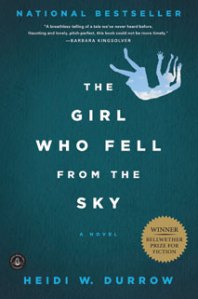
High school kids often find themselves struggling with parts of their life that 1) they don’t fully understand or even know that much about, and 2) affects how they embrace aspects of growing up, sometimes in confusing or harmful ways. The Girl Who Fell From the Sky tells the story of just such a high school girl. Besides also being a very readable and well-told tale, this makes it a valueable story for high school girls who wrestle with their own ghostly demons. As many of my students have told me, reading how others handle life situations helps them in handling their own.
That said, this is a mature tale, most suitable for the older teen reader, girls primarily, but thoughtful boys will like it also. It is told from perspectives alternating between several of the central characters. The plot centers on the girl who physically survives her mother’s murder/suicide jump from the roof of a building and who, understandably, is bumped around for years by the emotional damage. Yes, it is a harsh, tragic story, but amidst the lost, broken souls there are angel spirits who make all the difference.
Gaby








Crank by Ellen Hopkins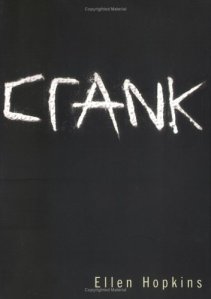
One of my students once told me that she liked the books she had been reading because they explained exactly what it was adults had been warning her about. Concerned adults can present information to young adults about things that might hurt them on their journey to adulthood and those young people may still wonder what exactly it is the adults are talking about. With a book like Crank, Ellen Hopkins’ fictionalized account of her own daughter’s descent into crank addiction, readers feel what addiction is as surely as they feel what something rotten in the stomach feels like. They will be able to recognize the monster whether it is a snake in the grass or it is rearing up its ugly head.
Hopkins’ books are all written in verse, arranged in different shapes on each page–the effect is as much a physical experience as a literary one and adds greatly to the impact. She tackles the most difficult subjects: abuse, suicide, addiction, and prostitution. Many teenage girls say that Ellen Hopkins speaks to and for them. But her books are disturbing, with an end effect of strengthening a commitment to a positive life.
Crank is followed by Glass which chronicles a further slide into addiction as the teenage girl, Bree, moves into adulthood. The third book in this series, the recently published Fallout tells the story of Bree’s children as they grow into adulthood. These are definitely books that adults would be interested in reading: for parents already close to their teenage children, these books will offer material for discussion; for parents drifting away from their maturing children, these books will inspire them to regain contact.
Gaby








I Love Yous Are For White People by Lac Su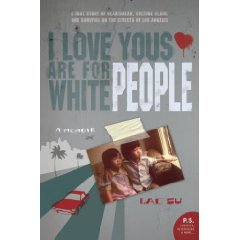
Dodging bullets to throw himself onto a boat which almost sinks in a violent storm is but the beginning of Lac Su’s harrowing life as a Viet Namese immigrant growing up in West LA. In his memoir, he does not flinch in capturing the peril of gaining asylum in an “American Heaven” that is in reality a dismal spot for a hazardous childhood in an alien culture. The result is a story that is not for those with a faint heart or a weak stomach.
Lac Su captures a story of sorrow, of longing, and of fear with grace and a quiet sense of humor. That he is now a happy family man with a PhD is a testimony to humankind’s ability to make it through the darkest days. This book will be of interest to high school kids of both genders. However, though it is not a challenging read, and a child lives through all the events portrayed, the content can only be classified as “mature.” The reader will feel compassion and horror, but will emerge the wiser.
Gaby






The Brothers Torres by Coert Voorhees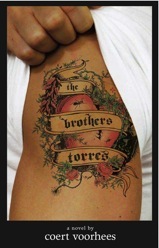
Frankie, a sophomore, has a highly respected older brother, a senior, who looks out for him. He gives him tips on how to act in a way that will earn him respect. In their small town in New Mexico, this means being seen as hard. What Frankie is trying to do is become a man. But it will not be advice that gets him there. It will be a split-second decision he makes in the face of cruelty that will define who he is and that will liberate him.
There is a saying comparing the making of sausage and the workings of politics that I think should include the navigation of high school life. This story of a boy finding his ground in a high school setting as he tries to mature into a man has much that is not pretty, including violence, drinking, drugs, and sexual insecurity. It is, however, a reality that many high school kids will recognize. It is also a book that shines light and brings heart to what can be a foggy world for some teens.
This well-written book is written from the perspective of a high school boy and will likely be most appreciated by high school boys. High school girls who like to learn about how boys think will also enjoy it. It is a little rough for all but the most well-read and wise middle school kids.
Gaby






The Truth About Forever, by Sarah Dessen
For years I gave my students books by Sarah Dessen to read because I was confident they would enjoy them. But I only found the time to read one myself just recently. Now I am even more confident. I love giving books to teenagers that I know will help them. Sarah Dessen writes as a beneficent adult but through the eyes and the soul of youth.
In The Truth About Forever, sixteen-year-old Macy Queen grieves for her recently deceased father as she navigates her goals, her peer relationships, and her shaken home-life. The clear path through comes from deeply buried instincts that seem to fly in the face of what she and her mother thought would get her through. But she makes it because of the unadorned goodness in others that draws her along.
I laughed, I wept, I got involved with the true-to-life characters in this book and wished to get back to them when I wasn’t reading. This is clearly a book for girls; the romance develops very slowly and is deeply committed. It is a story about strength, the power of love, and pulling through.
Gaby






Story of a Girl by Sara Zarr
Sometimes when I read a book written for young adults for review, I get impatient with the adolescent protagonist who seems to be wallowing in self-pity when his or her situation is just not that dire. That was the case with this book. But by the time I finished it I realized it was an accurate portrayal of how a teenager, in this case a girl, can get trapped in her own disillusionment. Physical and emotional maturity are looming, the safety of childhood is fading away, and her first forays into independence and maturity have left her feeling damaged. People who care for each other hurt each other, and then don’t know how to repair it. It makes for a sad read.
However, all is not lost. She can learn to accept small victories, and to take more charge of her life. This is a rite of passage for many young teenage girls. How I would like it if none of them had to go through it, but so many do and gain wisdom from it, wisdom that will serve them well as they grow into women. This is a book that can help girls who read it, to either recognize some of their own feelings, or realize how to avoid such feelings. Although the entire subject revolves around sex and friendship, there are no explicit scenes. For eight grade and up, I would say.
Gaby






The Perks of Being a Wallflower by Stephen Chbosky
Something is wrong with Charlie, the sixteen year old boy who narrates this story through letters written to an unspecified “friend.” He is subject to dramatic mood swings, has trouble with the art of truthtelling, and lacks social grace. The suspense that drives the story is the uncertainty over whether Charlie’s fragility will survive the onslaught of over-the-top adolescent hazards. Nothing is spared; there is drinking, violence, drugs, smoking, abuse, homosexuality, fast-driving, and explicit sex. Ironically, it is the realization of his dream of the tenderness of true love that pushes him over the brink, forcing him to finally come to terms with events in his early childhood that damaged him.
This novel has been compared to Catcher in the Rye. It is similar in that it too is a book that belongs to young people, in that it expresses the drive for a generational truth in still forming young minds. But Charlie is not as angry as Holden Caulfield. Charlie has more reason to complain and be vengeful but he is too devoted to the principal of love. And this is why he is able to face his demons and come to the conclusion that he cannot change his past, but he can make a better future for himself.
The explicit content in this book has made this a controversial book. It has been banned by adults, and teenagers have named it as the best book they have read–a book that has changed their lives and made them interested in reading. As an adult who finds books for kids, I found the content almost relentlessy disturbing–did they have to smoke too?–but I realize the content represents the minefield that a broken Charlie must navigate, and thus highlights both his strengths and his undeserved baggage. Teenagers brought this book into my classroom. Most of my students seem to know about this book, and some chose not to read it. That seems appropriate. It is their book, let them choose.
Gaby







 Crazy
Crazy— Eerdmans Books.




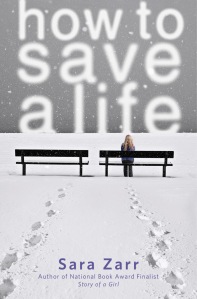
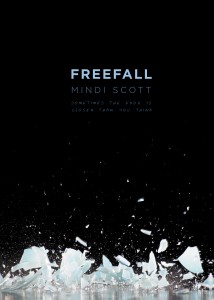













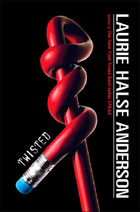

.jpg)
Sweet! Can't waint to see the finished piece. Welcome to Monday Artday!
very nice, can't wait to see it fleshed out!
Welcome! Looking forward to see ing your final painting.